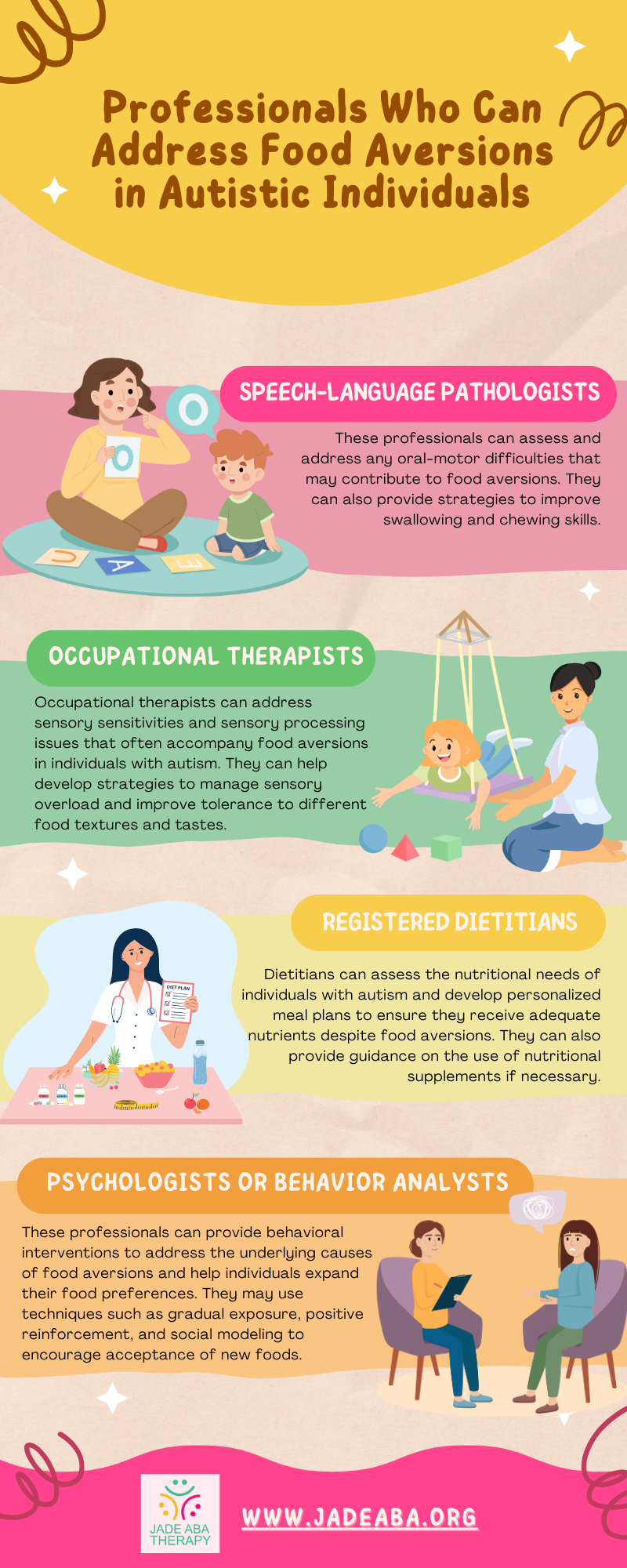Food aversions can be a common challenge that parents and caregivers of autistic individuals tend to face. Understanding the factors that contribute to these food aversions is key to finding effective strategies to address them.
In this article, we’ll look at the factors that impact food aversions in autism and how parents and caregivers can work around them.

Factors that Contribute to Food Aversions
There are several factors that can impact food aversions among autistic individuals. These factors can vary from sensory sensitivities to behavioral patterns and social or environmental influences.
Let’s look at each of them.
Texture and Consistency
Food texture and consistency are highlighted as the primary underlying factors influencing a child’s consumption or rejection of food. Research suggests that around a huge portion of children with autism avoid certain foods due to their textures.
Sensory sensitivity, particularly aversion to the texture of food, is the most common reason for food aversion among individuals with autism. It’s important to recognize that they may have heightened sensory processing issues, making certain textures unappealing or even overwhelming.
Behavioral Patterns
Behavioral patterns also play a role in food aversions among individuals with autism. Some individuals may exhibit rigidity or inflexibility in their eating habits, preferring a limited range of foods and resisting new or unfamiliar foods. This can be attributed to the need for routine and predictability, which is common in individuals with autism.
Understanding and addressing these behavioral patterns can help expand their food choices and promote a more balanced diet.
Social and Environmental Factors
Social and environmental factors can significantly impact food aversions in individuals with autism as well. Sensory processing disorders, which are common in autism, can affect eating habits.
Hyper- or hypo-sensitivity to stimuli like textures, smells, temperature, or colors can lead to aversions or preferences for specific foods.
Additionally, stress around socializing and the sensory experience of eating in public settings can contribute to food aversions. Creating a supportive and comfortable meal environment can help alleviate these factors and encourage a more positive eating experience.
By recognizing and addressing these factors, parents and caregivers can better understand the underlying causes of food aversions in individuals with autism. This understanding can guide the development of personalized strategies and interventions to expand the variety of foods consumed and promote a healthier relationship with food.

Food Aversions Across Ages
Food aversions are a common challenge experienced by individuals with autism, impacting both children and adults. Understanding how food aversions manifest at different stages of life is crucial for providing appropriate support and intervention.
Children with Autism
Children with autism are five times more likely to experience food aversions and have narrow food selections, leading to significant feeding problems.
Children with autism may experience challenges related to oral-motor skills. These skills involve muscle strength, range of motion, coordination, and sensory perception in the mouth tissues.
Difficulties with oral-motor skills can affect a child’s ability to handle and manipulate food, thus contributing to food aversions and eating problems.
Autistic Adults
Food aversions can also persist into adulthood for individuals with autism. Research shows that food aversion is common among autistic young people, with a significant number of parents reporting that their child eats a narrow range of food.
A study found that 67% of young people with autism experience eating problems, compared to only 33% of young people without autism.
As individuals with autism transition into adulthood, their food aversions may continue to impact their dietary choices and eating habits. It is essential for caregivers and support systems to be aware of these challenges and provide appropriate support and guidance.
Encouraging a diverse and balanced diet while considering the individual’s sensory sensitivities and preferences can help promote healthy eating habits.

How to Address Food Aversions
It’s important to approach treatment for food aversions in a personalized and supportive manner. By considering the unique needs and preferences of each individual, caregivers and healthcare professionals can help create a positive environment for mealtime and foster healthier eating habits.
There are several key approaches that we can follow which are as follows:
Personalized Treatment Approaches
In treating food aversions in individuals with autism, a personalized approach is essential. This involves tailoring the treatment plan to the specific needs and preferences of the individual.
Some of the most useful strategies that can be employed include:
- Building a meal plan around preferred foods – By incorporating familiar and preferred foods into the meal plan, individuals with autism may feel more comfortable and willing to try new foods gradually.
- Seeking nutritional advice – Consulting with a healthcare professional or registered dietitian who specializes in autism can provide valuable guidance in developing a balanced and nutritious meal plan that meets the individual’s dietary requirements.
- Gradual introduction of new foods – Introducing new foods with similar flavors or textures to the individual’s preferred foods can help ease the transition and increase the likelihood of acceptance.
Creating Supportive Meal Environments
To help individuals with autism overcome food aversions, it’s crucial to create a supportive meal environment that minimizes stress and sensory sensitivities. Here are some strategies that can be implemented:
- Provide familiar and healthy food options – Offer a variety of familiar and healthy foods to ensure the individual has options they feel comfortable with while still promoting a nutritious diet.
- Involve the individual in meal planning – Including the individual in meal planning can give them a sense of control and involvement. This can be done by allowing them to choose between different options or by involving them in the preparation process.
By adopting personalized treatment approaches and creating supportive meal environments, caregivers and healthcare professionals can help individuals with autism overcome food aversions and develop a healthier relationship with food.
It is important to remember that treatment should be tailored to the individual’s needs and preferences, and a multidisciplinary approach involving different professionals and services may be necessary for more severe cases.
Multidisciplinary Approach
A multidisciplinary approach involves the involvement of professionals from different fields who collectively work together to address food aversions in individuals with autism.
This team may include:

By adopting the above strategies, individuals with autism can receive the support they need to expand their food preferences and overcome food aversions.
That said, it’s important to remember that treatment strategies should be personalized and take into account the unique needs and challenges of each individual.
For families seeking professional support, ABA therapy in Maryland offers tailored strategies that can enhance coping skills and foster personal growth. To learn more about how Jade ABA Therapy can help, feel free to contact us today and explore the best solutions for your loved one.




